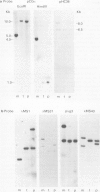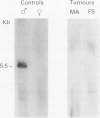Abstract
Genetic studies have been made in two cases of primary choriocarcinoma from patients in whom the antecedent pregnancy was a hydatidiform mole. Restriction fragment length polymorphisms of the DNA from the tumour, the patient and her partner were examined and in both cases the tumours were shown to be androgenetic in origin, having only paternal polymorphisms. While one tumour was shown to be heterozygous, two different paternal alleles being demonstrated with some probes, the other tumour was shown to be homozygous for all informative polymorphisms examined. Thus choriocarcinoma can follow complete hydatidiform mole which may be either heterozygous or homozygous.
Full text
PDF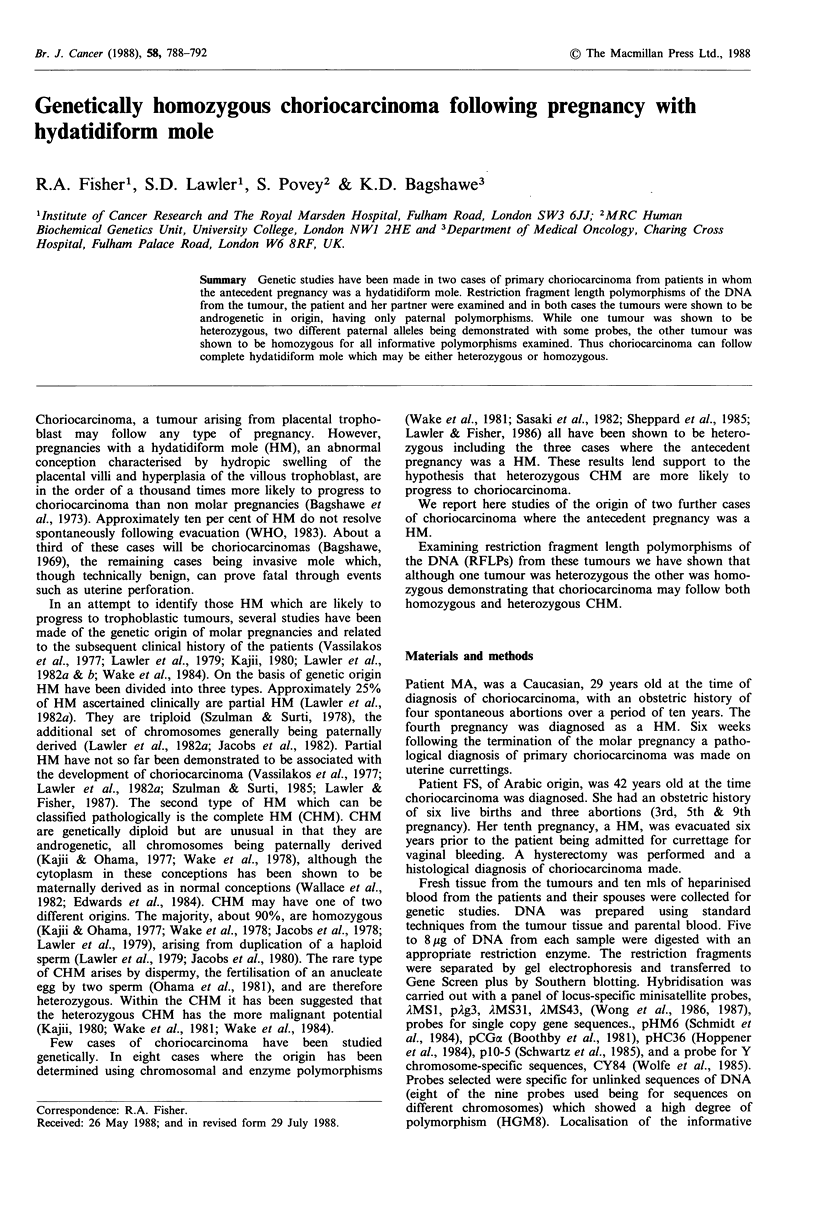
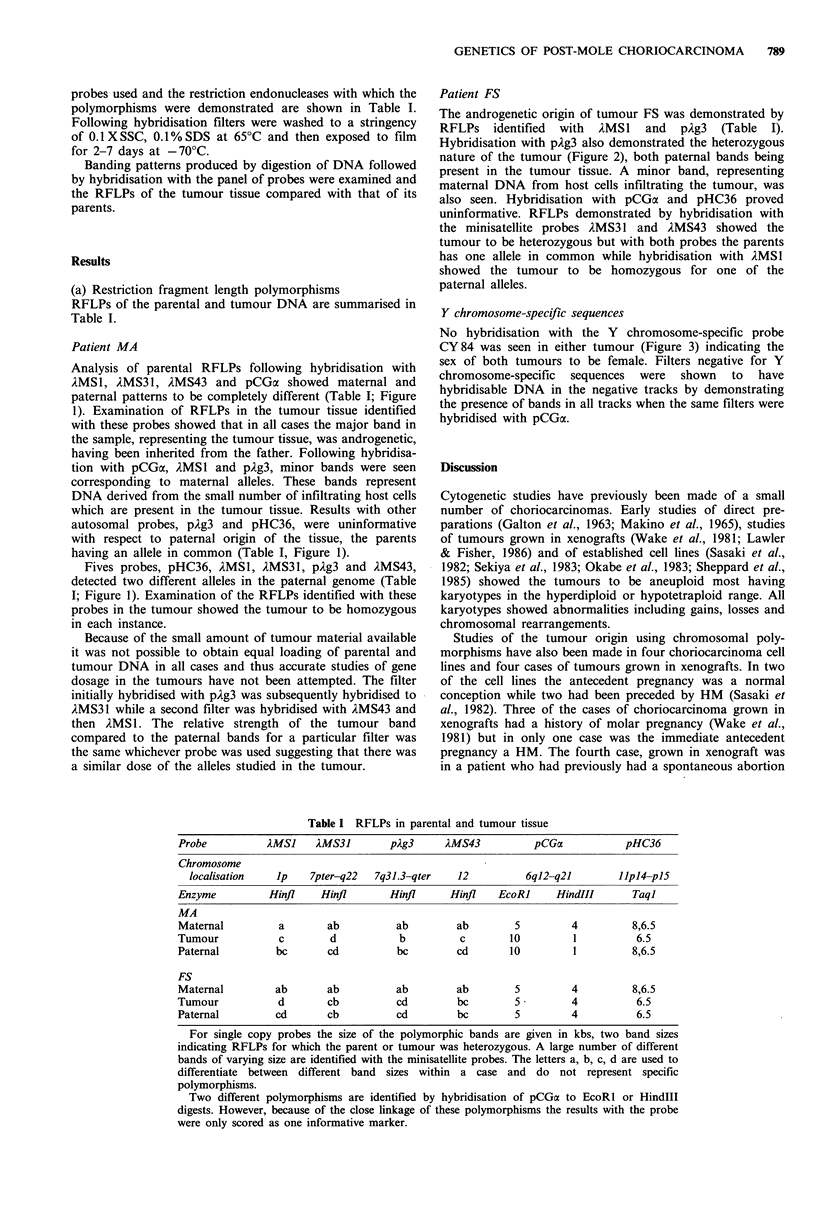
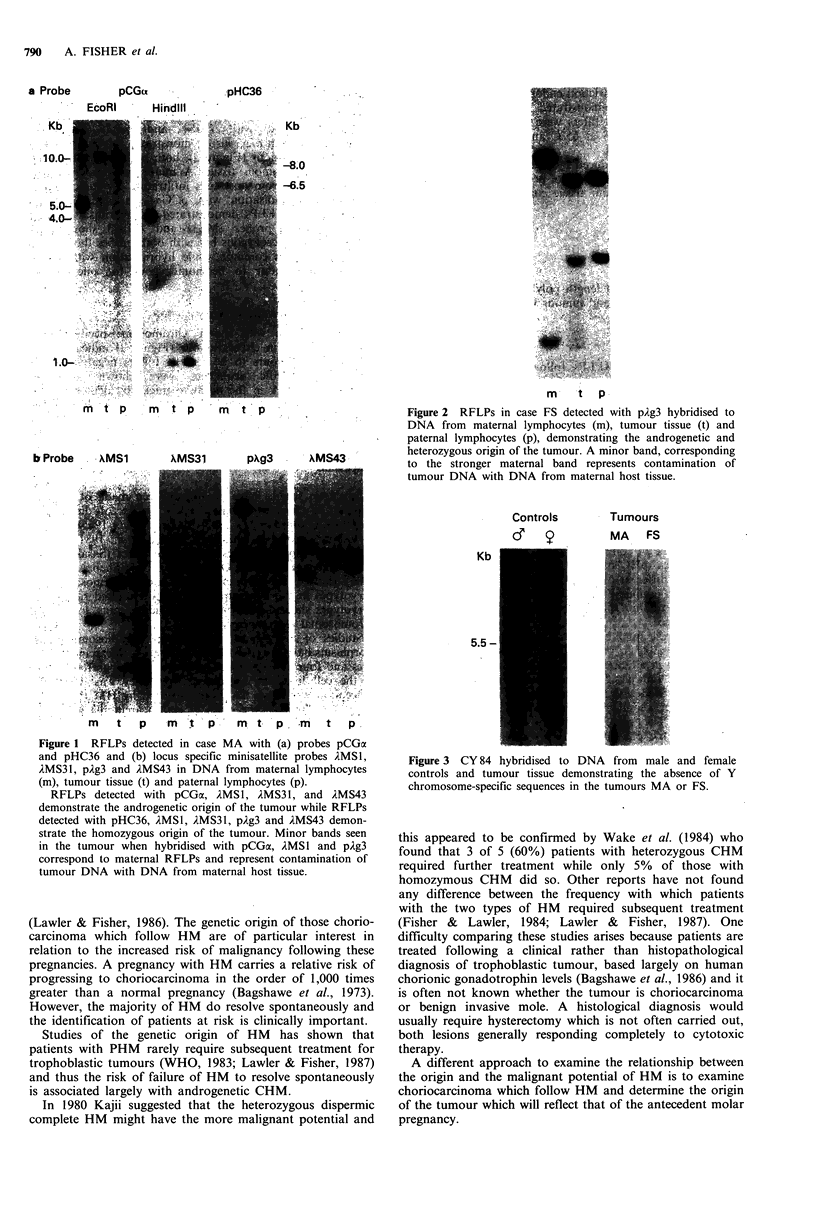
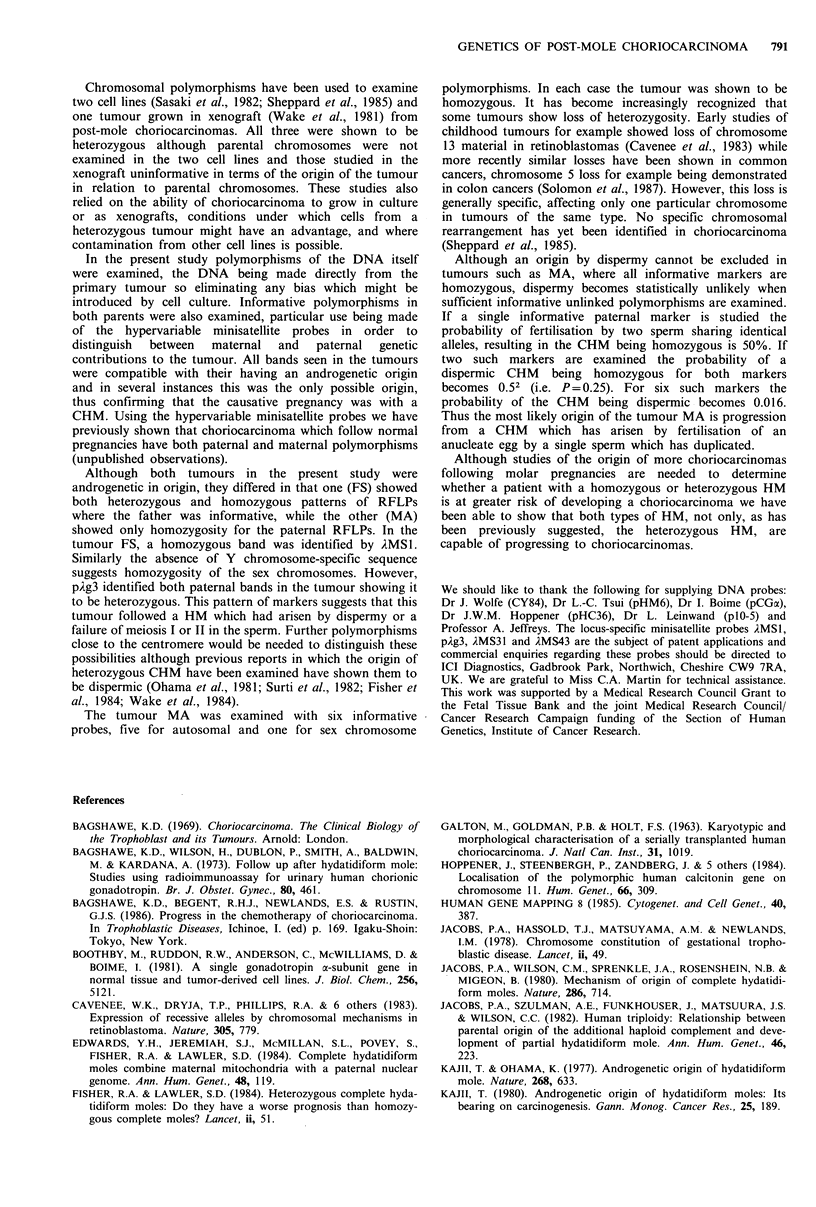
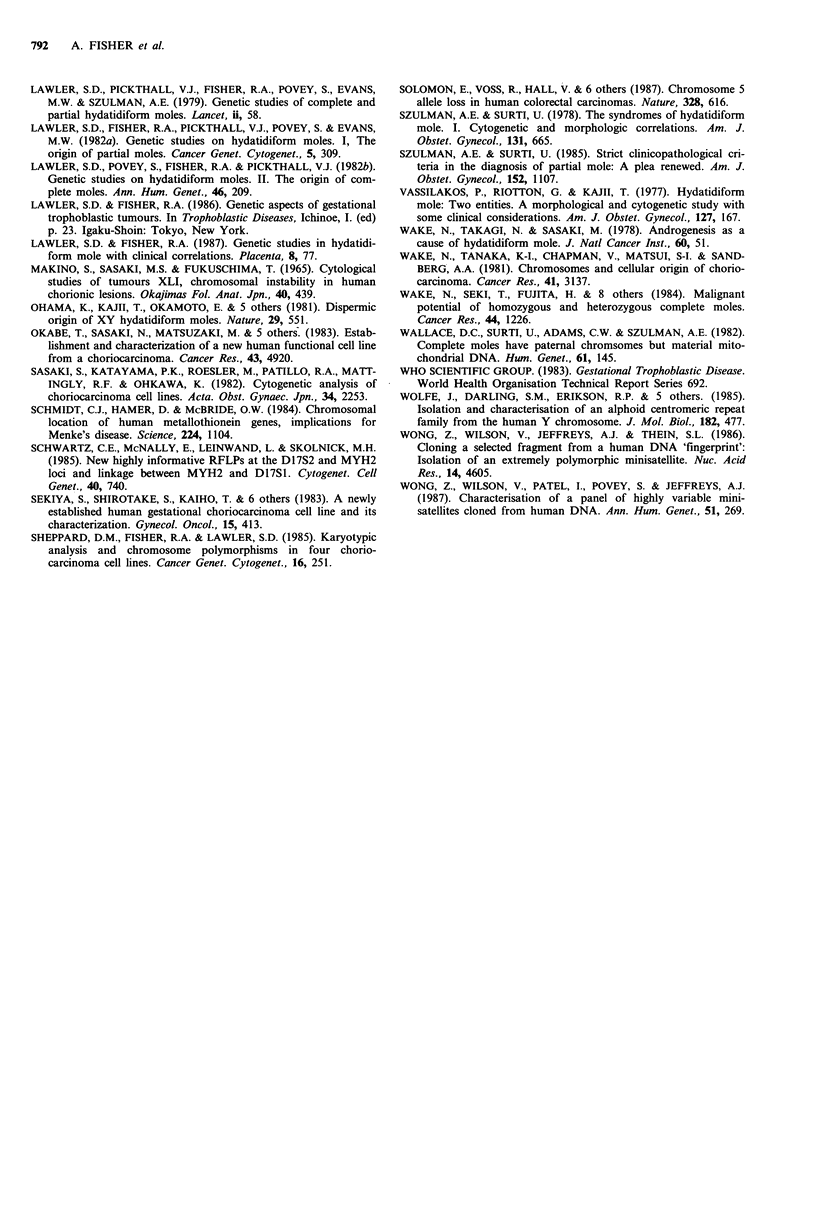
Images in this article
Selected References
These references are in PubMed. This may not be the complete list of references from this article.
- Bagshawe K. D., Wilson H., Dublon P., Smith A., Baldwin M., Kardana A. Follow-up after hydatidiform mole: studies using radioimmunoassay for urinary human chorionic gonadotrophin (HCG). J Obstet Gynaecol Br Commonw. 1973 May;80(5):461–468. doi: 10.1111/j.1471-0528.1973.tb15962.x. [DOI] [PubMed] [Google Scholar]
- Boothby M., Ruddon R. W., Anderson C., McWilliams D., Boime I. A single gonadotropin alpha-subunit gene in normal tissue and tumor-derived cell lines. J Biol Chem. 1981 May 25;256(10):5121–5127. [PubMed] [Google Scholar]
- Cavenee W. K., Dryja T. P., Phillips R. A., Benedict W. F., Godbout R., Gallie B. L., Murphree A. L., Strong L. C., White R. L. Expression of recessive alleles by chromosomal mechanisms in retinoblastoma. 1983 Oct 27-Nov 2Nature. 305(5937):779–784. doi: 10.1038/305779a0. [DOI] [PubMed] [Google Scholar]
- Edwards Y. H., Jeremiah S. J., McMillan S. L., Povey S., Fisher R. A., Lawler S. D. Complete hydatidiform moles combine maternal mitochondria with a paternal nuclear genome. Ann Hum Genet. 1984 May;48(Pt 2):119–127. doi: 10.1111/j.1469-1809.1984.tb01007.x. [DOI] [PubMed] [Google Scholar]
- Fisher R. A., Lawler S. D. Heterozygous complete hydatidiform moles: do they have a worse prognosis than homozygous complete moles? Lancet. 1984 Jul 7;2(8393):51–51. doi: 10.1016/s0140-6736(84)92047-6. [DOI] [PubMed] [Google Scholar]
- GALTON M., GOLDMAN P. B., HOLT S. F. KARYOTYPIC AND MORPHOLOGIC CHARACTERIZATION OF A SERIALLY TRANSPLANTED HUMAN CHORIOCARCINOMA. J Natl Cancer Inst. 1963 Oct;31:1019–1035. [PubMed] [Google Scholar]
- Höppener J. W., Steenbergh P. H., Zandberg J., Bakker E., Pearson P. L., Geurts van Kessel A. H., Jansz H. S., Lips C. J. Localization of the polymorphic human calcitonin gene on chromosome 11. Hum Genet. 1984;66(4):309–312. doi: 10.1007/BF00287635. [DOI] [PubMed] [Google Scholar]
- Jacobs P. A., Hassold T. J., Matsuyama A. M., Newlands I. M. Chromosome constitution of gestational trophoblastic disease. Lancet. 1978 Jul 1;2(8079):49–49. doi: 10.1016/s0140-6736(78)91363-6. [DOI] [PubMed] [Google Scholar]
- Jacobs P. A., Szulman A. E., Funkhouser J., Matsuura J. S., Wilson C. C. Human triploidy: relationship between parental origin of the additional haploid complement and development of partial hydatidiform mole. Ann Hum Genet. 1982 Jul;46(Pt 3):223–231. doi: 10.1111/j.1469-1809.1982.tb00714.x. [DOI] [PubMed] [Google Scholar]
- Jacobs P. A., Wilson C. M., Sprenkle J. A., Rosenshein N. B., Migeon B. R. Mechanism of origin of complete hydatidiform moles. Nature. 1980 Aug 14;286(5774):714–716. doi: 10.1038/286714a0. [DOI] [PubMed] [Google Scholar]
- Kajii T., Ohama K. Androgenetic origin of hydatidiform mole. Nature. 1977 Aug 18;268(5621):633–634. doi: 10.1038/268633a0. [DOI] [PubMed] [Google Scholar]
- Lawler S. D., Fisher R. A. Genetic studies in hydatidiform mole with clinical correlations. Placenta. 1987 Jan-Feb;8(1):77–88. doi: 10.1016/0143-4004(87)90041-5. [DOI] [PubMed] [Google Scholar]
- Lawler S. D., Fisher R. A., Pickthall V. J., Povey S., Evans M. W. Genetic studies on hydatidiform moles. I. The origin of partial moles. Cancer Genet Cytogenet. 1982 Apr;5(4):309–320. doi: 10.1016/0165-4608(82)90096-6. [DOI] [PubMed] [Google Scholar]
- Lawler S. D., Povey S., Fisher R. A., Pickthall V. J. Genetic studies on hydatidiform moles. II. The origin of complete moles. Ann Hum Genet. 1982 Jul;46(Pt 3):209–222. doi: 10.1111/j.1469-1809.1982.tb00713.x. [DOI] [PubMed] [Google Scholar]
- MAKINO S., SASAKI M. S., FUKUSCHIMA T. CYTOLOGICAL STUDIES OF TUMORS. XLI. CHROMOSOMAL INSTABILITY IN HUMAN CHORIONIC LESIONS. Okajimas Folia Anat Jpn. 1965 Jan;40:439–465. doi: 10.2535/ofaj1936.40.4-6_439. [DOI] [PubMed] [Google Scholar]
- Ohama K., Kajii T., Okamoto E., Fukuda Y., Imaizumi K., Tsukahara M., Kobayashi K., Hagiwara K. Dispermic origin of XY hydatidiform moles. Nature. 1981 Aug 6;292(5823):551–552. doi: 10.1038/292551a0. [DOI] [PubMed] [Google Scholar]
- Okabe T., Sasaki N., Matsuzaki M., Imai Y., Kaneko Y., Matsuzaki F., Takaku F., Tsushima T. Establishment and characterization of a new human functional cell line from a choriocarcinoma. Cancer Res. 1983 Oct;43(10):4920–4926. [PubMed] [Google Scholar]
- Pasculle A. W., Myerowitz R. L., Rinaldo C. R., Jr New bacterial agent of pneumonia isolated from renal-transplant recipients. Lancet. 1979 Jul 14;2(8133):58–61. doi: 10.1016/s0140-6736(79)90117-x. [DOI] [PubMed] [Google Scholar]
- Sasaki S., Katayama P. K., Roesler M., Pattillo R. A., Mattingly R. F., Ohkawa K. Cytogenetic analysis of choriocarcinoma cell lines. Nihon Sanka Fujinka Gakkai Zasshi. 1982 Dec;34(12):2253–2256. [PubMed] [Google Scholar]
- Schmidt C. J., Hamer D. H., McBride O. W. Chromosomal location of human metallothionein genes: implications for Menkes' disease. Science. 1984 Jun 8;224(4653):1104–1106. doi: 10.1126/science.6719135. [DOI] [PubMed] [Google Scholar]
- Sekiya S., Shirotake S., Kaiho T., Iwasawa H., Kawata M., Higaki K., Ishige H., Takamizawa H., Minamihisamatsu M. A newly established human gestational choriocarcinoma cell line and its characterization. Gynecol Oncol. 1983 Jun;15(3):413–421. doi: 10.1016/0090-8258(83)90060-4. [DOI] [PubMed] [Google Scholar]
- Sheppard D. M., Fisher R. A., Lawler S. D. Karyotypic analysis and chromosome polymorphisms in four choriocarcinoma cell lines. Cancer Genet Cytogenet. 1985 Apr 1;16(3):251–258. doi: 10.1016/0165-4608(85)90052-4. [DOI] [PubMed] [Google Scholar]
- Solomon E., Voss R., Hall V., Bodmer W. F., Jass J. R., Jeffreys A. J., Lucibello F. C., Patel I., Rider S. H. Chromosome 5 allele loss in human colorectal carcinomas. Nature. 1987 Aug 13;328(6131):616–619. doi: 10.1038/328616a0. [DOI] [PubMed] [Google Scholar]
- Szulman A. E., Surti U. Strict clinicopathologic criteria in the diagnosis of partial hydatidiform mole: a plea renewed. Am J Obstet Gynecol. 1985 Aug 15;152(8):1107–1108. doi: 10.1016/0002-9378(85)90572-1. [DOI] [PubMed] [Google Scholar]
- Szulman A. E., Surti U. The syndromes of hydatidiform mole. I. Cytogenetic and morphologic correlations. Am J Obstet Gynecol. 1978 Jul 15;131(6):665–671. doi: 10.1016/0002-9378(78)90829-3. [DOI] [PubMed] [Google Scholar]
- Vassilakos P., Riotton G., Kajii T. Hydatidiform mole: two entities. A morphologic and cytogenetic study with some clinical consideration. Am J Obstet Gynecol. 1977 Jan 15;127(2):167–170. doi: 10.1016/s0002-9378(16)33244-6. [DOI] [PubMed] [Google Scholar]
- Wake N., Seki T., Fujita H., Okubo H., Sakai K., Okuyama K., Hayashi H., Shiina Y., Sato H., Kuroda M. Malignant potential of homozygous and heterozygous complete moles. Cancer Res. 1984 Mar;44(3):1226–1230. [PubMed] [Google Scholar]
- Wake N., Takagi N., Sasaki M. Androgenesis as a cause of hydatidiform mole. J Natl Cancer Inst. 1978 Jan;60(1):51–57. doi: 10.1093/jnci/60.1.51. [DOI] [PubMed] [Google Scholar]
- Wake N., Tanaka K., Chapman V., Matsui S., Sandberg A. A. Chromosome and cellular origin of choriocarcinoma. Cancer Res. 1981 Aug;41(8):3137–3143. [PubMed] [Google Scholar]
- Wallace D. C., Surti U., Adams C. W., Szulman A. E. Complete moles have paternal chromosomes but maternal mitochondrial DNA. Hum Genet. 1982;61(2):145–147. doi: 10.1007/BF00274205. [DOI] [PubMed] [Google Scholar]
- Wolfe J., Darling S. M., Erickson R. P., Craig I. W., Buckle V. J., Rigby P. W., Willard H. F., Goodfellow P. N. Isolation and characterization of an alphoid centromeric repeat family from the human Y chromosome. J Mol Biol. 1985 Apr 20;182(4):477–485. doi: 10.1016/0022-2836(85)90234-7. [DOI] [PubMed] [Google Scholar]
- Wong Z., Wilson V., Jeffreys A. J., Thein S. L. Cloning a selected fragment from a human DNA 'fingerprint': isolation of an extremely polymorphic minisatellite. Nucleic Acids Res. 1986 Jun 11;14(11):4605–4616. doi: 10.1093/nar/14.11.4605. [DOI] [PMC free article] [PubMed] [Google Scholar]
- Wong Z., Wilson V., Patel I., Povey S., Jeffreys A. J. Characterization of a panel of highly variable minisatellites cloned from human DNA. Ann Hum Genet. 1987 Oct;51(Pt 4):269–288. doi: 10.1111/j.1469-1809.1987.tb01062.x. [DOI] [PubMed] [Google Scholar]



